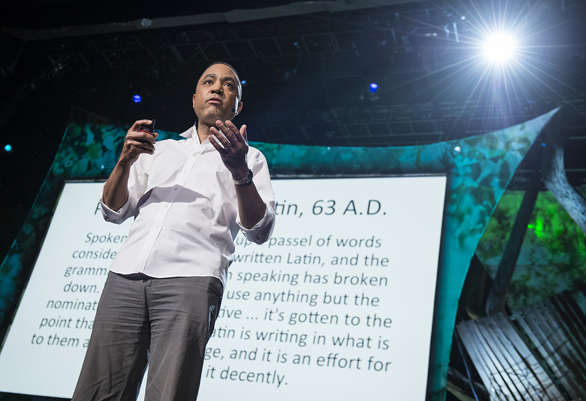
John McWhorter asks us to think of texting less as “written language” and more as “fingered speech.” Photo: James Duncan Davidson
Texting is not a blight on the English language, says linguist John McWhorter in today’s talk, given at TED2013. Rather, texting is a “miraculous thing”: a novel linguistic mode that’s redefining the way we communicate with each other — for the better.
 John McWhorter: Txtng is killing language. JK!!!
McWhorter points out that texting shouldn’t be categorized as written language –but as speech. This shift makes the apparent problem of grammatical errors seem misplaced and unimportant.
John McWhorter: Txtng is killing language. JK!!!
McWhorter points out that texting shouldn’t be categorized as written language –but as speech. This shift makes the apparent problem of grammatical errors seem misplaced and unimportant.
If we think of texting as “fingered speech,” as McWhorter puts it, it also opens our eyes to texting’s distinct linguistic rules, structures and nuances. McWhorter dives into the example of “lol,” which originally stood for “laughing out loud.” But over the past few years, “lol” has “evolved into something that is much subtler,” signifying empathy and accommodation.
As the mediums through which we communicate quickly multiply, our modes of communication are following suit. After you’ve watched the talk, here are some more examples of new linguistic forms that have developed in tandem with technology.
- Like “lol,” hashtags started out with a literal function: making topics easy to tag, and thus search for, on Twitter. But in 2010, Susan Orlean, a writer and avid tweeter, pointed out that hashtags had taken on an emotional resonance. Orlean gives this (dated, sorry) example: “Sarah Palin for President??!? #Iwouldratherhaveamoose.” She writes that, while no one would search for “Iwouldratherhaveamoose,” its use here “makes it look like it’s being muttered into a handkerchief; when you read it you feel like you’ve had an intimate moment in which the writer leaned over and whispered ‘I would rather have a moose!’ in your ear.” Hashtags can also be used to indicate a joke, or even — when employed back-to-back –comment on the hashtag that came before. “Amazing how rich and complex 140 characters with a few symbols thrown in can be,” Orlean writes. And how much richer they are now, three years later.
. - GIFs, those omnipresent video loops, are nothing new: they date back to 1987. But in recent years, they’ve started to populate blogs and articles, standing in for written descriptions, often to hilarious effect. Take #WhatShouldWeCallMe (there’s that hashtag again!), a Tumblr started by two friends in law school on opposite sides of the country, where Austin Powers stands in for the boundless joy of discovering your roommate has cleaned and a panda illustrates massive post-party regret. Or this personal essay about a New Yorker’s experience during Hurricane Sandy, where the accompanying GIFs help make the horrifying event lighter and easier to process.
. - “Fingered speech” though it may be, cellphone communication is generating new avenues for writing, too. In 2008, The New York Times reported from Japan that cellphone novels (what they sound like: novels written on cellphones) had dominated the previous year’s list of best-selling books. One woman wrote hers, which hit number five on the best-sellers list, during her commute to work. “[M]any cellphone novelists had never written fiction before, and many of their readers had never read novels before, according to publishers,” the Times article notes. (A 2010 Los Angeles Times article indicated the trend was still in full force.)
. - More recently, Twitter, too, has been coopted as a tool for fiction. Last year, Jennifer Egan wrote a short story in 140-character nuggets, which were posted on Twitter before they were published in The New Yorker as “Black Box.” A few months later, novelist Elliott Holt wrote her own http://storify.com/penguinpress/elliotholt-s-twitterfiction-story”>Twitter story, creating three different avatars/characters and posting from “their” accounts. “The three characters have distinct voices—and by telling the story through them, Holt embraces Twitter for what it is, rather than trying to bend it into some tool that it isn’t,” Slate opined. “With its simultaneous narrators and fractured storyline, this is not the kind of tale that could march steadily across a continuous expanse of white space. It’s actually made for the medium.”
. - Email signoffs, as all things, have their haters: many a screed has implored humanity to dispense with these vulgar written appendages. (Admittedly, this rant in Slate is hilarious: “My transition from signoff submissive to signoff subversive began when a former colleague ended an email to me with ‘Warmest regards.’ Were these scalding hot regards superior to the ordinary ‘Regards’ I had been receiving on a near-daily basis?”) But others among us appreciate the space for expression that signoffs offer. Sadie Stein, in the Paris Review Daily, explains her own choice, “As ever.” And a few years ago, The New York Times offered this survey of signoffs from a bishop’s “+” to Norman Mailer’s “Cheers” to the author’s own “Carpe Diem.”
John McWhorter was a part of TED’s worldwide talent search, giving a shorter version of his talk at the New York stop of the tour. After the talk, he sat down with the TED Blog for this short Q&A »
McWhorter would also like to thank his students at Columbia University for teaching him about the new world of texting: specifically Yin Yin Lu, Sarah Tully, and Laura Milmed for the miracle of “slash.”
Comments (22)
Pingback: Millennials deal with harsh criticism | Coyote Chronicle